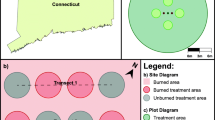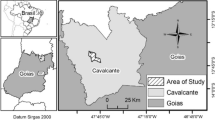Abstract
Alcoa of Australia Limited has been rehabilitating bauxite mines in the jarrah (Eucalyptus marginata) forest of Western Australia for more than 30 years. Mines rehabilitated in the early 1980s using out-dated methods have built up substantial fuel loads that may be reduced through prescribed burning. The vegetation response of 11–13 year-old rehabilitated bauxite mines to fire regimes differing in intensity and season over the first two years of post-burn succession is compared to the native jarrah forest. A total of 243 species from 137 genera and 56 families were identified in the native forest reference sites and in the 11–13 year-old rehabilitated areas before and after burning. The vegetation of the pre-burn rehabilitated areas was very different to that of the native jarrah forest. While total live plant cover, Acacia density, non-native eucalypt seedling density, weed density and the evenness index were similar between the two areas, total plant density, live Acacia cover, the proportion of weeds, native species numbers and diversity were significantly different. However, the greatest difference between the vegetation of the pre-burn rehabilitated sites and the native jarrah forest was the higher dominance of seeding species (plants killed by fire) in rehabilitated areas. In contrast, native jarrah forest was dominated by resprouting species (plants that survive fire). Burning the rehabilitated sites was successful in making the areas more similar to the forest in terms of total plant density, live Acacia cover and native species numbers but decreased their similarity in terms of live plant cover, Acacia density, non-native eucalypt seedling density, weed density and evenness. The vegetation response of the rehabilitated areas to different seasons of burning showed that autumn burning led to a greater increase in plant establishment than spring burning. Autumn burning also resulted in an undesirable increase in the density of non-native eucalypt seedlings that was not observed following spring burning. Although burning these 11–13 year-old rehabilitated sites will increase similarity to the native forest, it is unlikely that they will resemble the native jarrah forest without further management intervention.
Similar content being viewed by others
Author information
Authors and Affiliations
Rights and permissions
About this article
Cite this article
Grant, C., Loneragan, W. The effects of burning on the understorey composition of 11–13 year-old rehabilitated bauxite mines in Western Australia – Vegetation characteristics. Plant Ecology 145, 291–305 (1999). https://doi.org/10.1023/A:1009821128075
Issue Date:
DOI: https://doi.org/10.1023/A:1009821128075




